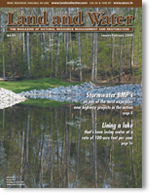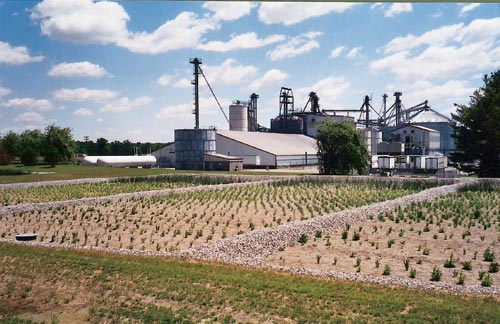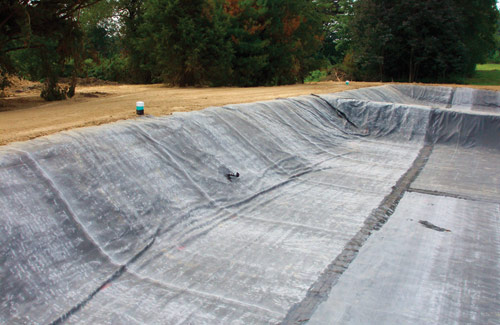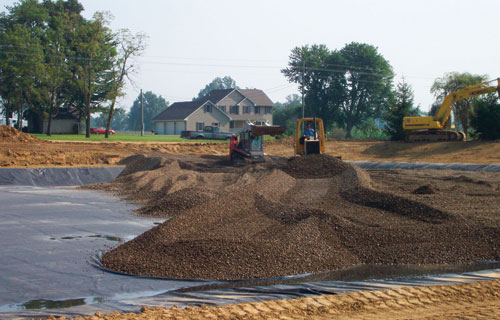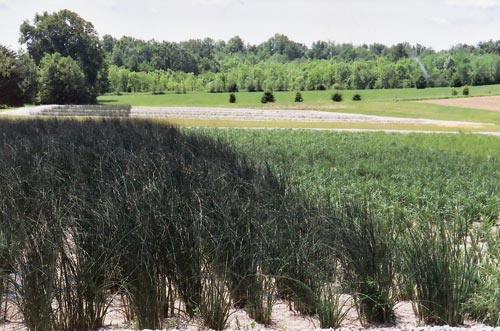Constructed Wetlands Meet Environmental and Cost Requirements for Rose Acre Farmsby Bill Johnson |
||
Rose Acre Farms, headquartered just west of Seymour, Ind., operates a soybean meal processing plant and is one of the world’s largest egg production operations. Founded in the 1930s, approximately 75 percent of Rose Acre’s egg production is used for fresh table eggs. The remaining 25 percent is processed into a variety of fresh liquid, frozen and dried egg products. The company is well respected for the quality, value and freshness of its products, and prides itself on its commitment to environmental stewardship. Among Rose Acre Farms’ goals are staying ahead of environmental regulations, being a good neighbor, and leaving things cleaner than how they found them. So when it came time to address storm water runoff and wastewater treatment at its soybean meal processing plant, which processes eight million bushels of soybeans a year, the management team at Rose Acre Farms directed its attention to a unique, environmentally responsible method of treatment: constructed wetlands. In the past, Rose Acre Farms’ wastewater had been handled solely by a package treatment plant. Although the system worked well enough, it was high maintenance and operationally intensive. For storm water treatment, Rose Acre previously used septic tanks to treat runoff generated from the five-acre soybean processing plant and a maintenance garage. But in times of heavy rains, the runoff was so extreme that water and bean husks filled ditches around the property and nearby roadways. Researching various options for the best solution was the responsibility of Natural Concepts Engineering, Inc., a water quality engineering firm located in Indianapolis. According to Tony Wesner, executive vice president and manager of environmental affairs for Rose Acre Farms, Natural Concepts constructed a couple of pilot wetland projects for Rose Acre on a much smaller scale and one sizable system at the company’s hatchery.
“We started experimenting with wetlands about five years ago and built a small one at our egg-breaking facility that would handle about 6,000 gallons per day. We were taking 6,000 biochemical oxygen demand (BOD) water a day through a constructed wetland and coming out the other end at 150 BOD or less. That’s a dramatic reduction,” Wesner stated. “After building a larger wetland at the hatchery and seeing the results, we were convinced that constructed wetlands are an economical and environmentally responsible way to treat wastewater and storm water.” Although constructed wetlands are a fairly new method of water treatment in the United States, these systems have been widely tested and used in Europe since the 1960s in a variety of applications.
Meeting All Requirements “Staying in compliance is easier and less time consuming with a constructed wetland because the wetland does so much of the work itself,” said Alan Stout, processing plant manager for Rose Acre Farms. “We used to spend an incredible amount of time on our daily cleaning practices in order to stay in compliance. The wetland, on the other hand, does the cleaning on its own due to the biological activity happening below the surface.” For the wastewater wetland, a permit is only required of industrial dischargers if they increase their capacity and/or change their pollutant discharge loading. Since Rose Acre did not fall into either of these categories, no permit was required. (For private dischargers, a construction permit is required from the Indiana State Department of Health, much like one would get a building permit to put an addition on a house.) In terms of testing and reporting for the wastewater constructed wetland, there are 10 areas in which IDEM requires monthly reporting: 1) temperature of discharge; 2) oxygen level; 3) pH level; 4) total suspended solids; 5) oil and grease content; 6) ammonia level; 7) chloride level; 8) BOD level; 9) average discharge per day for the month (in gallons), and maximum high for the month; and 10) total monthly discharge. Rose Acre is diligent about these reporting practices, but Stout said it is no more time consuming than with the conventional wastewater processing system.
Wetland Design Two separate units were built approximately 30 feet apart. The storm water treatment wetland covers 0.6 acres and is served by two pump stations having a combined capacity of 1,900 gallons per minute. Vortex pretreatment units precede the pump stations for solids removal. According to Wesner, an average of 100 semi-trailers come through the soybean plant every day during the fall of the year. These trucks are covered in grain dust, which collects on a large blacktop driveway. When it rains and washes off the drive, there is the potential for a lot of polluted water leaving the property. Rose Acre was concerned this could be an environmental matter for its property, as well as a concern to neighbors, if not properly addressed. “Storm water hits all at once, so you can’t really predict how much is going to flow through the system,” Harrison explained. “The wetland is designed to accommodate up to one inch of rainfall. The storm water wetland takes a large ‘first flush’ of storm water, fills up and then slowly treats and releases it.” Rose Acre Farms’ previous system, according to Wesner, was very unforgiving in terms of being able to address fluctuating levels of incoming water. Wetlands, conversely, are not sensitive to these changes and provide better results day in and day out. The wastewater treatment wetland was designed as a pretreatment system for the existing water treatment plant. This wetland covers 0.9 acres and has an average daily design flow of 30,000 gallons per day. In contrast to storm water, wastewater runoff occurs at a fairly steady pace and, therefore, the treatment process also occurs at a more fixed rate. “Rose Acres’ wastewater treatment wetland is a relatively large application of a subsurface flow constructed wetland,” Harrison commented. “The typical design handles only a couple thousand gallons of water each day. The sheer size of this project makes it unique.” How it Works In general terms, a subsurface flow wetland consists of a basin, sometimes called a “cell,” that is lined with a barrier to prevent seepage. The basin is then filled with gravel to support the root structure of aqueous vegetation, which is planted directly into the gravel. The plants then translocate oxygen down to the roots through the plant. This oxygen forms aerobic areas that sustain bacteria and other microorganisms that live in the gravel and root zone. The bacteria do all the work of removing the pollutants in the water. Moreover, the sun is the only energy source used to treat the water. During winter months when plants move into a dormant phase, the roots remain active and the oxygen transfer remains steady. Therefore, the system performs just as efficiently in sustained cold temperatures.
“There’s an incredible amount of biological activity happening in a relatively small space,” Harrison added. “For a typical pond to accomplish the same thing as this one-acre wetland, it would have to cover at least three to four acres.” Moreover, because there’s no standing water in a subsurface flow wetland, there is almost no likelihood of producing mosquitoes, and odor is not a factor. Specification of the Lining Material Natural Concepts had used a variety of lining materials prior to the Rose Acre project and specified PondGardâ EPDM Rubber Liner from Firestone Building Products Company based on its performance advantages. “PondGard offers exceptional elasticity and conformity to irregular shapes,” Harrison said. “Odd shapes are often used either to make the system more efficient, or for aesthetic reasons where a client doesn’t want a huge square or rectangle. The rubber liner conforms to these odd shapes better than other products we’ve looked at.” He added, “Ease of installation and ease of seaming the rubber membrane panels together are two other important reasons I like using this product. Literally all of our clients have agreed with us on this.” In fact, the liners are so easy to use that Rose Acre Farms installed it themselves with minimal training from a Firestone representative. Rose Acre was able to use most of its own construction equipment to dig two rectangular cells. After digging the two cells, Rose Acre utilized skid steer loaders and rubber-tired pay loaders to assist in stretching the lining material out across the cells. Once the material was in place and the seams were welded, loaders and earthmoving equipment were used to fold the dirt over the perimeter of the liner at the top edge of the basin to hold the material in place.
Each cell took a single day to line with the rubber liner. “The installation was quick and simple to do, and we are very satisfied with the performance of the water-tight seams and puncture resistant material,” Wesner stated. “We’ve had no problems with the liner. We’ve dealt with some other products in the past and have experienced a variety of problems with them, such as leaking seams and air bubbles. The liners perform extremely well and we are confident that Firestone will stand behind its product. That’s important to us.” A Whole New Paradigm “Once the plants are fully established, it should be very nice to look at,” Harrison commented, noting that about 90 percent of the plants survived the winter and more were planted in spring 2005. “The owner’s house is immediately adjacent to the wetlands, so it was imperative that we make them look nice. In fact, you would never know the constructed wetlands were there. You’d just think it was an open field of plants.” Harrison added, “This is one of the huge advantages of subsurface flow constructed wetlands. Once the plant life is mature, you practically forget they are even there. Most water treatment plants have large signs that say, ‘Danger! Keep Out!’ There’s actually a constructed wetland in California with a sign next to it that says, ‘Welcome! Enjoy!’ It’s a whole new paradigm.” Constructed wetland systems offer numerous benefits, from economical, operational and environmental perspectives. “There isn’t a downside,” Harrison said. “They provide a simple, low-cost, natural treatment alternative to conventional water treatment options.” According to Harrison, both the wastewater and storm water constructed wetlands met the farm’s objective of providing environmentally sound water treatment while reducing operating and maintenance costs. “This system uses no motors, whereas most water treatment options are mechanically intensive. Constructed wetlands use only plants and sunlight to accomplish their purpose, and no harvesting of plants is necessary (which would be a major operational cost) in order to maintain proper levels of biological activity,” he said. The absence of pumps and other mechanical equipment translates into greatly reduced utility bills and no need for special training of an operations staff. Additionally, constructed wetlands handle variables much better than traditional, operationally intensive forms of water treatment. If there’s a power outage, there’s no concern that the system will shut down. If there’s a torrential rain, there’s no concern the treatment plant will become overwhelmed. “We are very pleased with the outcome of our constructed wetlands,” Wesner said. “I believe that in the somewhat near future, many other agricultural facilities—those similar to ours as well as livestock operations—will have to address their storm water and wastewater treatment in more environmentally stringent ways due to governmental regulations. We have found that constructed wetlands offer an affordable, low maintenance and extremely efficient option.” As an added benefit, building the constructed wetlands prevented Rose Acre from having to expand its wastewater processing system due to Storm Water Pollution Prevention Plan guidelines. “This system is priceless,” Stout remarked. “It’s performing beyond our expectations.” For more information, contact Firestone Specialty Products, Bill Johnson, Field Sales Engineer, 310 East 96th Street, Indianapolis, IN 46240, (800) 428-4442, (317) 575-7100 or JohnsonBill@firestonebp.com. |
©2006 - 1998 Land and Water, Inc.

